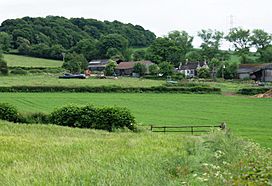Jones' Hill Wood facts for kids
Quick facts for kids Jones' Hill Wood |
|
|---|---|

The wood behind Durham Farm in 2010
|
|
| Map | |
| Lua error in Module:Location_map at line 420: attempt to index field 'wikibase' (a nil value). | |
| Geography | |
| Location | Buckinghamshire, England |
| Area | 1.8 hectares (4.4 acres) |
| Ecology | |
| Dominant tree species | Beech |
| Lesser flora | Bluebell, dog’s mercury, dog’s violet, primrose |
| Fauna | Badgers, bats, foxes, tawny owls |
Jones' Hill Wood is a special forest that covers about 1.8-hectare (4.4-acre) of land. It's located near Wendover in Buckinghamshire, England. This wood is considered an ancient woodland, which means it has been a forest for a very long time.
Most of the trees here are beech trees. Jones' Hill Wood is also part of the beautiful Chiltern Hills Area of Outstanding Natural Beauty. Sadly, almost half of this wood is planned to be cut down. This is to make way for a new railway line called High Speed 2 (HS2). The topsoil, which is the rich upper layer of earth, is planned to be moved. In October 2020, people who were protesting to save the wood were asked to leave.
About Jones' Hill Wood
Jones' Hill Wood is a small but important forest. It is located between Great Missenden and Wendover in Buckinghamshire. This area is known for its natural beauty.
The wood is home to many different plants and animals. You can find beech trees, which are very common here. The forest also provides a home for animals like badgers, bats, foxes, and tawny owls. In spring, the forest floor is covered with beautiful bluebells. You might also spot dog’s mercury, dog’s violet, and primrose flowers.
Did you know that the famous author Roald Dahl lived nearby? He lived in Great Missenden. Some people say that his walks in these woods inspired parts of his book Fantastic Mr Fox. However, other stories suggest a different wood, Angling Spring Wood, was the inspiration.
The HS2 Railway Project
The High Speed 2 (HS2) project is building a new railway. This railway will connect cities like Birmingham and London. When the project was first planned, about 1 hectare (2.5 acres) of Jones' Hill Wood was going to be cleared. Later, this amount was reduced to about 0.7 hectares (1.7 acres).
HS2 plans to plant 4.1 hectares (10 acres) of new woodland to make up for the trees they cut down. This means nearly half of Jones' Hill Wood will be removed. Jones' Hill Wood is one of 20 ancient woodland sites that HS2 plans to move. This process is called "translocation." It means they will try to move the topsoil to a new location. However, Natural England, a government body that protects nature, has said that it's impossible to truly move an ancient woodland.
Protests to Save the Wood
In March 2020, a protest camp was set up at Jones' Hill Wood. People wanted to stop the trees from being cut down. They used a method called tree sitting, where they lived in treehouses. The camp was eventually cleared by authorities in October 2020.
On the first day, 40 people were removed from the woods. The next day, a local councillor was arrested. He had been living in a tree for three months. He returned to the wood a few days later to join other activists. After eight days, the last protestor to be removed was a well-known environmental activist named Swampy. He was taken from a treehouse that was 80-foot (24 m) high. He and six other people faced legal action for being on the land without permission.
After the protest camp was cleared, a report found something important. It showed that rare barbastelle bats were living in Jones' Hill Wood. Lawyers then asked HS2 to stop clearing the site. They wanted a full study to be done. They also suggested that HS2's permit from Natural England might not cover destroying bat homes.
Felling of Trees
In March 2021, Natural England gave HS2 a special permit for bats. This permit allowed HS2 to destroy four places where pipistrelle bats rested and one breeding spot. HS2 started cutting down two-thirds of the wood in April 2021. Four protestors were arrested during this time.
A local farmer, whose family name inspired a character in Roald Dahl's Fantastic Mr Fox, spoke about the wood. He said, "It used to be full up with primroses, foxgloves, bluebells, wood anemones, all sorts of things." On April 16, a judge told HS2 to stop cutting trees until at least May 24. This was to allow time for a legal review of Natural England's decision. However, on April 26, Mr Justice Holgate overturned that decision, allowing the tree felling to continue.

